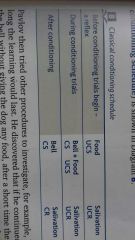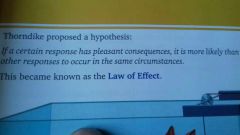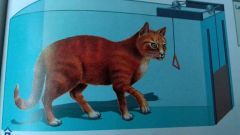![]()
![]()
![]()
Use LEFT and RIGHT arrow keys to navigate between flashcards;
Use UP and DOWN arrow keys to flip the card;
H to show hint;
A reads text to speech;
30 Cards in this Set
- Front
- Back
- 3rd side (hint)
|
Learning |
A relatively permanent change in behiour due to experience |
|
|
|
Classical conditioning |
A procedure during which an animal or person learns to associate a reflex response to a new stimulus |
|
|
|
Classical conditioning schedule |
The steps in a procedure to condition a new response |
|
|
|
Unconditioned stimulus (UCS) |
The stimulus that produces a reflex response |
The food for pavlov's dog |
|
|
Unconditioned response (UCR) |
The reflex response to a an unconditioned stimulus |
Pavlov's dog's salivation |
|
|
Conditioned response (CR) |
The response that is learnt; it occurs when the CS has been presented |
Salivation to the bell sound not food |
|
|
Extinction |
When a conditioned response dies out. (Stops taking place) |
|
|
|
Spontaneous recovery |
A conditioned response that has disappeared suddenly reappears again. |
|
|
|
Generalisation |
When a conditioned response is produced when a similar stimulus to the original is presented. |
|
|
|
Discrimination (in conditioning) |
The conditioned response is only produced when a specific stimulus is presented. |
|
|
|
Schedule of conditioning |

|
|
|
|
Schedule of conditioning |

|
|
|
|
Classical conditioning experiment- baby Albert |
Aim: To see if one can condition fear in humans Method: 11 month old Albert seemed to like white mice and had no fears of white furry things. Mouse was presented, when he reached for it a metal bar was hit hard behind his back (a sound he was previously scared of). This was repeated. Results: He became scared of the mouse and would scream when he saw it, even without the loud noise. He also got scared of a fur coat and Santa mask. Conclusion: this shows a fear response can be learnt through classical conditioning. |
|
|
|
Operant conditioning |
Learning through consequences of behaviour, through positive or negative reinforcement. |
|
|
|
Operant conditioning |
Learning through consequences of behaviour, through positive or negative reinforcement. |
|
|
|
Law of effect |

Behaviours that are followed by rewards are more likely to be repeated than those with out. |
|
|
|
Thorndike experiment- operant conditioning |
Thorndike placed a cat in a box where the aim was for the cat to escape. The box contains a string which was attached to a latch. when the string was pulled the latch would open and the cat could escape. The first time the cat was placed in the box it moved around and accidentally pulled the string. This happened until about 20 trails after which the cat began to escape very quickly. Thorndike suggested that the cat had learnt to escape due to trail and error learning. It was the pleasant consequence that encourage the cat to pull the string rather than produce any other behaviour. |

|
|
|
Reinforcement (negative-positive) |
Positive reinforcement is when you give a reward or pleasant consequence, negative reinforcement is when you take away something unpleasant, directly after a behaviour. These both increase the likelihood of the behaviour being repeated. |
|
|
|
Punishment (negative-positive) |
Negative punishment is when you take away something pleasant after an unwanted behaviour, positive punishment is when you give an unpleasant consequence after an unwanted behaviour. These both help reduce the likelihood of unwanted behaviours being repeated. |
|
|
|
Behaviour shaping |
Changing behaviour in small steps |
|
|
|
B F Skinner- reinforcement in operant conditioning |
A hungry rat would be placed in a box. The rat would produce a variety of movements which would accidentally cause the rat to touch a lever. This lever would make a food pellet immediately drop into the food tray. Every time the level was pressed the behaviour was positively reinforced by a food pellet. (positive reinforcement) Sometime there would be an electric shock through the floor of the box which would only stop when the lever was pressed by the rat. (negative reinforcement |
Skinner box with rats |
|
|
Phobia |
A persistent and irrational fear of an object, activity or situation. The typical symptoms are intense feelings of fear and anxiety towards that thing |
|
|
|
Flooding |
A treatment for phobias that involves the immediate exposure of the person to the feared object, activity or event, until there is no fear response |
|
|
|
Systematic desensitisation |
A treatment for phobias in which the person is taught to relax and is then gradually exposed to the feared object, activity or event |
|
|
|
Hierarchy of fears |
A series of feared events ranked from the least feared to the most |
|
|
|
Systematic desensitisation treatment |
- The person with a phobia is taught how to relax themselves. - The person and therapist construct a hierarchy of fears that contains the things they are afraid of in order from least frightening (the word 'spider') to most frightening (holding a spider in my hand) - the person relaxes and then gradually works through the hierarchy of fears, relaxing after each feared event is presented. The person only moves up a level if they were completely relaxed at the previous stage |
|
|
|
Aversion therapy |
A treatment for addictions (e.g. drug/alcohol dependency) which makes the addict have an extremely negative reaction to the addictive substance. This usually requires the use of using drugs which cause immediate vomiting |
|
|
|
Classical conditioning procedure with aversion therapy |
Emetic----------------> Vomiting UCS UCR Alcohol + emetic -----> Vomiting CS + USC UCR Alcohol -------------------> Vomiting CS CR |
|
|
|
Token economy programmes |
Programmes that are set up to reward socially acceptable behaviours in people who may have stopped looking after themselves properly. Every time a person produces an appropriate behaviour, staff immediately give them a token. |
|
|
|
Token economy programmes evaluation |
Positive:- have produced improvements in behaviour and self-care of patients who have been in institutions for a long time. Negative:- some critics argue that they make people focus on the reward rather than on wanting their own behaviour improve. - some suggest that, when we learn to produce behaviour only because we receive 'tokens' we will not become social or kind humans. They say that we need to learn to do good things for the reward of feeling good about that rather than always being given physical rewards |
|

